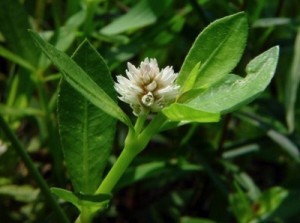Alternanthera philoxeroides: Exotic Munch
If you have alligators you have alligator weed. That’s a little odd because alligator weed is a native of South America where there are no alligators. But now Alligator Weed is found in the same waters as alligators, and many other places as well.
Introduced into the United States around 1894, it is an invasive weed in many states. It’s also a little-known edible though it is in the amaranth clan. One place it is eaten a lot is Burma but it does come with a warning.
One PhD expert says raw it tastes better than many salad greens and some in a salad is fine. In other words, when green it can be a garnish or a salad addition. Another says more than 100 grams dry weight ( 3.5 oz dry, which probably translates into a half a pound or more wet weight) might provide too much calcium oxalate, a bad dose. The point is don’t dry it and eat 3.5 ounces of it. Some raw in your salad is fine. Also cooking can reduce the calcium oxalate in greenery.
The botanical name, Alternanthera philoxeroides, means “alternate flower like the philoxerus.” It is said alter-NANTH-er-uh fil-oh-zer-OY-deez, or Alter-ann-THER-rah fie-lox-er-OH-deez. And indeed it does resemble the philoxerus but that is now called the Blutaparon vermiculare, which only grows near salt water. The A. philoxeroides can tolerate some brackish water.
There are many Alternanthera in warmer areas so key out the plant carefully. A. philoseroides is the most common. Four known edibles are A. ficoidea, A sessilis, A. sissoo, and A. versicolor. A. sessilis is well-distributed in the U.S., A. ficoieda is rare. A. versicolor is found in Asia. A sissoo is a common green in South America but must be cooked.
Green Deane’s “Itemized” Plant Profile
Identification
“A. philoxeroides: A perennial herb; stems creeping or floating, ascending towards apex, rooting at the lower nodes, branched, hollow, with a longitudinal hairy groove on 2 opposite sides. Leaves subsessile or with petiole to 5 mm long, with a ring of white hairs between the 2 opposite leaf bases. Lamina 3-13 x 1-3.5 cm, elliptic to oblanceolate or obovate, glabrous or slightly hairy near the attenuate base; apex obtuse or acute. Inflorescences in upper axils, mostly 1-2 cm in diameter, capitate, white; pedicles to 9 cm long with 2 opposite longitudinal hairy grooves, occasionally heads shortly pedunculate and terminal. Bracts 2.5-3.5 mm long, ovate-acuminate; bracteoles similar to bracts, somewhat smaller, persistent. Tepals 5-7 mm long, oblong to ovate, acute or obtuse. Fertile stamens 5; staminodes = stamens. Style short, thick; stigma capitate.” (Webb et al, 1988; p. 101).
Time Of Year
Nearly year round
Environment
In fresh water, or on damp land, can also tolerate some brackish water.
Method Of Preparation
Leaves in small amounts raw, also as a cooked green.



love your videos and this website. can you tell me what are some books you would recommend for me to get .i love wild plants and i eat some already but i would like to know more about them.p.s. do you ever come to louisiana to do classes or anything. thanks
I’ll be getting close to Louisiana with classes in Pensacola this year. Books… there is one call Edible Plants of the Gulf South by Charles Allen. No drawings worth mentioning, nor indepth descriptions. But it is in one place a compilation of edible plants in your area. That and photos off the internet should help a lot.
Would this do well at the edge of a brackish water lake in zone 10?
It is usually found only in fresh water.
There is a new study that found that the calcium in alligator weed actually contains much less oxalates than many other green leafy vegetables. As a result, the calcium in this plant is more bio-available. Additionally, cooking did not significantly affect this bioavailability. Good Stuff!
Here’s the study: http://www.sciencedirect.com/science/article/pii/S0308814614012461
Claims from the National Institute of Health that it could be a promising treatment for Dengue Fever as well.
http://www.ncbi.nlm.nih.gov/pmc/articles/PMC3765846/
Is A. braziliana and other ornamentals of that genus edible? Thanks
I don’t see it listed as edible.
Look into this, it is mentioned as being eaten. Hope tis helps. https://www.researchgate.net/publication/271074574_Traditional_Vegetables_in_Benin
I down loaded that PDF and cannot find the word Alligator in it. They do mention Alternanthera brasiliana and A. sessilis.
Is it also called the dimond flower. I see the same picture in the following website.https://www.epls1.com/whats-that-weed.html